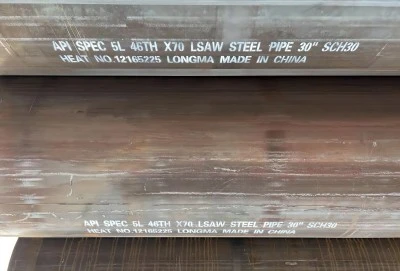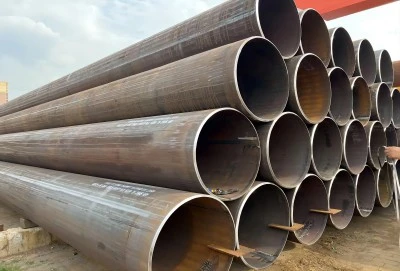When it comes to designing and operating pipeline systems, understanding the maximum allowable stress of API 5L X70 pipe is crucial for ensuring safety, reliability, and longevity. This high-strength steel pipe grade is widely used in the oil and gas industry, known for its exceptional performance under demanding conditions. In this comprehensive guide, we'll delve into the intricacies of determining and managing the maximum allowable stress for X70 pipe, exploring the factors that influence it and how to optimize its use in various applications.
|
|
|
How is the maximum allowable stress for X70 pipe determined?
The process of determining the maximum allowable stress for API 5L X70 pipe involves a complex interplay of material properties, design standards, and safety factors. Let's break down the key components that contribute to this critical calculation:
1.Material Properties:
X70 pipe is characterized by its high yield strength, typically around 485 MPa (70,300 psi). This inherent strength forms the foundation for calculating the maximum allowable stress. However, it's not just about the raw numbers; the pipe's microstructure, which consists of a fine-grained mixture of ferrite and pearlite, plays a vital role in its performance under stress.
2.Safety Factors:
To account for uncertainties in material properties, manufacturing variations, and potential operational hazards, safety factors are applied to the yield strength. These factors, often determined by industry standards and regulatory requirements, ensure that the pipe operates well below its theoretical limits, providing a margin of safety.
3.Design Codes and Standards:
Various international standards and codes govern the design and operation of pipelines using X70 pipe. For instance, ASME B31.8 for gas transmission and distribution piping systems provides guidelines for calculating maximum allowable operating pressure (MAOP), which is directly related to the maximum allowable stress.
4.Operational Considerations:
The intended use of the pipeline, including the type of fluid being transported, operating pressure, and environmental conditions, all factor into the determination of maximum allowable stress. For example, pipelines operating in corrosive environments or subject to cyclic loading may require more conservative stress limits.
5.Calculation Methods:
The actual calculation of maximum allowable stress typically involves applying a design factor to the specified minimum yield strength (SMYS) of the X70 pipe. This design factor, which can vary based on the application and location of the pipeline, ensures that the operating stress remains well below the yield point of the material.
For instance, a common formula used in the industry is:
Maximum Allowable Stress = SMYS * Design Factor
Where the design factor might be 0.72 for a typical onshore pipeline, resulting in a maximum allowable stress of about 349 MPa (50,600 psi) for X70 pipe.
What are the engineering limits for maximum stress on X70 pipe?
While the calculation of maximum allowable stress provides a safe operating range, it's equally important to understand the engineering limits of API 5L X70 pipe. These limits represent the absolute boundaries beyond which the pipe's integrity could be compromised.
1.Yield Strength:
The yield strength of X70 pipe, at 485 MPa (70,300 psi), represents the point at which the material begins to deform plastically. Operating beyond this limit can lead to permanent deformation and potential failure of the pipeline.
2.Ultimate Tensile Strength:
The ultimate tensile strength of X70 pipe is typically around 570 MPa (82,700 psi). This represents the maximum stress the material can withstand before fracture occurs. However, it's crucial to note that pipelines are never designed to operate anywhere near this limit.
3.Fatigue Limits:
Under cyclic loading conditions, such as those experienced in offshore applications or areas with significant temperature fluctuations, the fatigue limit becomes a critical consideration. This limit is typically much lower than the yield strength and requires careful analysis to prevent fatigue-induced failures over the lifespan of the pipeline.
4.Burst Pressure:
The burst pressure, which is the internal pressure required to cause rupture of the pipe, is an essential engineering limit. For X70 pipe, this is significantly higher than the maximum allowable operating pressure but serves as a crucial safety benchmark in design calculations.
5.Buckling Resistance:
In scenarios where external pressures are a concern, such as in deep-water applications, the buckling resistance of X70 pipe becomes a limiting factor. This resistance is influenced by the pipe's diameter-to-thickness ratio and material properties.
6.Fracture Toughness:
The ability of X70 pipe to resist crack propagation, particularly at low temperatures, is a critical engineering limit. The Charpy V-notch impact test is often used to quantify this property, with minimum requirements specified based on the operating environment.
How does temperature affect the allowable stress of X70 pipe?
Temperature plays a significant role in determining the allowable stress of API 5L X70 pipe, influencing its mechanical properties and overall performance. Understanding these effects is crucial for designing and operating pipelines across various environmental conditions.
1.Low-Temperature Effects:
At low temperatures, steel generally becomes stronger but less ductile. For X70 pipe:
- Yield and tensile strengths typically increase
- Ductility and toughness may decrease, potentially leading to brittle behavior
- The ductile-to-brittle transition temperature becomes a critical consideration
To account for these effects, designers often specify more stringent toughness requirements for pipelines operating in cold climates. The use of low-temperature-resistant steels or the application of more conservative design factors may be necessary.
2.High-Temperature Effects:
As temperatures increase:
- The yield strength of X70 pipe gradually decreases
- Creep deformation becomes a concern, especially for temperatures above 350°C (662°F)
- The risk of hydrogen-induced cracking may increase in certain environments
For pipelines operating at elevated temperatures, such as those transporting hot oil or in geothermal applications, the maximum allowable stress must be adjusted downward to account for the reduction in material strength.
3.Temperature-Induced Stresses:
Temperature fluctuations can induce additional stresses in pipelines due to thermal expansion and contraction. These thermal stresses must be considered when determining the overall stress state of the pipe and may necessitate the use of expansion loops or other stress-relief mechanisms in the pipeline design.
4.Material Selection Considerations:
While X70 pipe offers excellent performance across a wide temperature range, extreme conditions may require the use of specialized materials or coatings. For instance:
- Arctic-grade steels for extremely low-temperature applications
- Heat-resistant alloys for high-temperature service
- Corrosion-resistant alloys or coatings for aggressive environments
5.Operational Adjustments:
To maintain safe operation within allowable stress limits across varying temperature conditions, pipeline operators may need to implement:
- Temperature monitoring systems
- Pressure adjustment protocols based on temperature changes
- Periodic inspection and integrity assessment programs
By carefully considering the impact of temperature on the allowable stress of X70 pipe, engineers can ensure the safe and efficient operation of pipelines across diverse environmental conditions.
Longma Group
Understanding the maximum allowable stress of API 5L X70 pipe is fundamental to the design, construction, and operation of safe and efficient pipeline systems. By considering material properties, engineering limits, and environmental factors such as temperature, engineers can optimize the use of X70 pipe while maintaining a robust margin of safety.
As pipeline technology continues to evolve, ongoing research and development in materials science and engineering are pushing the boundaries of what's possible with high-strength steels like X70. This continuous improvement not only enhances the performance and reliability of pipeline systems but also opens up new possibilities for challenging applications in the oil and gas industry and beyond.
For those involved in pipeline projects utilizing X70 pipe, staying informed about the latest developments in stress analysis, material testing, and regulatory standards is crucial. By leveraging this knowledge, stakeholders can make informed decisions that balance safety, efficiency, and cost-effectiveness in their pipeline operations.
If you're looking for high-quality X70 pipe for your next project or have questions about maximizing its performance, don't hesitate to reach out to our team of experts at info@longma-group.com. We're here to help you navigate the complexities of pipeline design and ensure your project's success.














